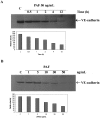Platelet-activating factor regulates cadherin-catenin adhesion system expression and beta-catenin phosphorylation during Kaposi's sarcoma cell motility
- PMID: 15855650
- PMCID: PMC1620029
- DOI: 10.1016/s0002-9440(10)62367-x
Platelet-activating factor regulates cadherin-catenin adhesion system expression and beta-catenin phosphorylation during Kaposi's sarcoma cell motility
Abstract
In the present study, we evaluated whether motility of Kaposi's sarcoma (KS) cells induced by platelet-activating factor (PAF) is dependent on the regulation of adherens junctions components. The results obtained indicate that PAF dose and time dependently reduced the endogenous expression of the main components of the adherens junctions: VE-cadherin, alpha-catenin, and beta-catenin. In addition, PAF initiated events that directly or indirectly up-regulated both the tyrosine and serine/threonine phosphorylation pathways, and both types of phosphorylation of beta-catenin were involved in the motility of KS cells. This motility was abrogated by addition of the tyrosine kinase inhibitor genistein, suggesting that this phosphorylation is an important signal responsible for breaking down the adherens junctions and diminishing the ability of neighboring cells to interact. Furthermore, immunofluorescence analysis showed that beta-catenin and VE-cadherin staining changed from a uniform distribution along the membrane of controls to a diffuse pattern with gap formation in PAF-treated KS cells. In conclusion, the data presented here indicate that PAF induces tumor cell motility by altering cell-cell adhesion through beta-catenin phosphorylation.
Figures








Similar articles
-
Tyrosine phosphorylation of human keratinocyte beta-catenin and plakoglobin reversibly regulates their binding to E-cadherin and alpha-catenin.J Invest Dermatol. 2001 Nov;117(5):1059-67. doi: 10.1046/j.0022-202x.2001.01523.x. J Invest Dermatol. 2001. PMID: 11710913
-
Proline-rich tyrosine kinase 2 (Pyk2) mediates vascular endothelial-cadherin-based cell-cell adhesion by regulating beta-catenin tyrosine phosphorylation.J Biol Chem. 2005 Jun 3;280(22):21129-36. doi: 10.1074/jbc.M500898200. Epub 2005 Mar 18. J Biol Chem. 2005. PMID: 15778498
-
Motility induced by human immunodeficiency virus-1 Tat on Kaposi's sarcoma cells requires platelet-activating factor synthesis.Am J Pathol. 1999 Nov;155(5):1731-9. doi: 10.1016/S0002-9440(10)65488-0. Am J Pathol. 1999. PMID: 10550329 Free PMC article.
-
Cadherin-catenin complex: protein interactions and their implications for cadherin function.J Cell Biochem. 1996 Jun 15;61(4):514-23. doi: 10.1002/(SICI)1097-4644(19960616)61:4%3C514::AID-JCB4%3E3.0.CO;2-R. J Cell Biochem. 1996. PMID: 8806074 Review.
-
Extracellular regulation of cancer invasion: the E-cadherin-catenin and other pathways.Biochem Soc Symp. 1999;65:43-62. Biochem Soc Symp. 1999. PMID: 10320932 Review.
Cited by
-
Activation of platelet-activating factor receptor and pleiotropic effects on tyrosine phospho-EGFR/Src/FAK/paxillin in ovarian cancer.Cancer Res. 2008 Jul 15;68(14):5839-48. doi: 10.1158/0008-5472.CAN-07-5771. Cancer Res. 2008. PMID: 18632638 Free PMC article.
-
Sex Hormones and Inflammation Role in Oral Cancer Progression: A Molecular and Biological Point of View.J Oncol. 2020 Jun 27;2020:9587971. doi: 10.1155/2020/9587971. eCollection 2020. J Oncol. 2020. PMID: 32684934 Free PMC article. Review.
-
H9c2 Cardiomyocytes under Hypoxic Stress: Biological Effects Mediated by Sentinel Downstream Targets.Oxid Med Cell Longev. 2021 Sep 30;2021:6874146. doi: 10.1155/2021/6874146. eCollection 2021. Oxid Med Cell Longev. 2021. PMID: 34630851 Free PMC article.
-
Platelet-Activating Factor Acetylhydrolase Expression in BRCA1 Mutant Ovarian Cancer as a Protective Factor and Potential Negative Regulator of the Wnt Signaling Pathway.Biomedicines. 2021 Jun 22;9(7):706. doi: 10.3390/biomedicines9070706. Biomedicines. 2021. PMID: 34206491 Free PMC article.
-
The Role of Curcumin in Prostate Cancer Cells and Derived Spheroids.Cancers (Basel). 2022 Jul 9;14(14):3348. doi: 10.3390/cancers14143348. Cancers (Basel). 2022. PMID: 35884410 Free PMC article.
References
-
- Prescott SM, Zimmerman GA, McIntyre TM. Platelet-activating factor. J Biol Chem. 1990;265:17381–17384. - PubMed
-
- Kume K, Shimizu T. Platelet-activating factor (PAF) induces growth stimulation, inhibition, and suppression of oncogenic transformation in NRK cells overexpressing the PAF receptor. J Biol Chem. 1997;272:22898–22904. - PubMed
-
- Boccellino M, Biancone L, Cantaluppi V, Ye RD, Camussi G. Effect of platelet-activating factor receptor expression on CHO cell motility. J Cell Physiol. 2000;183:254–264. - PubMed
-
- Takeichi M. Cadherin cell adhesion receptors as a morphogenetic regulator. Science. 1991;251:1451–1455. - PubMed
Publication types
MeSH terms
Substances
LinkOut - more resources
Full Text Sources
Medical
Miscellaneous

